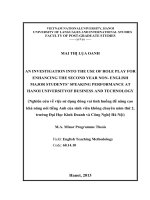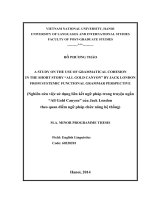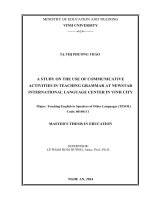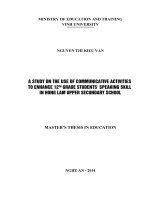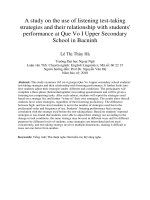A research into the role and the use of first language in General-English classes at Hanoi University of Industry
Bạn đang xem bản rút gọn của tài liệu. Xem và tải ngay bản đầy đủ của tài liệu tại đây (422.24 KB, 9 trang )
A research into the role and the use of first
language in General-English classes at Hanoi
University of Industry
Đỗ Thị Khánh Vân
Trường Đại học Ngoại Ngữ
Luận văn ThS. Chuyên ngành: English language; Mã số: 60 22 15
Người hướng dẫn: Dr. Ha Cam Tam
Năm bảo vệ: 2010
Abstract: The debate over whether English language classrooms should include or exclude
students’ native language has been a contentious issue for a long time (Brown, 2000, p195),
but not so many findings have been published in the case of Vietnamese as the mother
tongue. This paper will attempt to prove that L1 use deserves to be used despite the risk of
over-reliance on it by demonstrating that using L1 has two enhancing roles to play in
vocabulary teaching. Firstly, L1 use increases students’ participation in class time activities;
and secondly, it helps students learn the vocabulary better. Two experiments were carried out
in an attempt to substantiate these theories. In the first, four classes of 100 students at
elementary level were observed over a period of three weeks, during which time two classes
were English-only, and in the others, both teacher and students utilized Vietnamese. The
progress of these four classes is compared and then discussed. In the second experiment, two
separate lessons given to one class are compared (one with Vietnamese use, and one without).
Despite problems with causality and perhaps the inability to generalize the findings, overall
findings do indicate possible support for the researcher’s theories, and thereby for the use of
L1 in the classroom.
Keywords: Tiếng Anh; Phương pháp giảng dạy; Ngôn ngữ thứ nhất.
Content:
i
TABLE OF CONTENT
Acknowledgement
Abstract
INTRODUCTION 1
1. Problem statement 1
2. Aims of the study 2
3. Scope of the study 3
4. Method of the study 3
5. Organization of the study 4
DEVELOPMENT 5
Chapter 1: Literature review 5
1.1. The historical view of the issue 5
1.2. The current mixed views 8
1.2.1. Support for the Monolingual Approach 8
1.2.2. Support for the Bilingual Approach 9
1.3. Approaches to vocabulary teaching 13
1.4. Adults L2 vocabulary acquisition model 13
1.5. Action research 15
Chapter 2: The study 18
2.1. Design of the study 18
2.1.1. Research hypotheses 18
2.1.2. Data collection instruments 18
2.1.3. Participants 21
2.1.4. Procedures 21
2.2. Analytical framework 23
Chapter 3: Analysis and discussion 24
3.1. Data preparation 24
3.2. Scoring the data 24
3.2. Results of the tests 25
3.4. Results of classroom observation 31
CONCLUSION AND IMPLICATIONS 37
ii
1. Concluding remarks 37
2. Implications 37
3. Suggestions for further studies 38
Reference
Appendixes
1
INTRODUCTION
1. Problem statement
Among a number of experts in the field of second language acquisition, there are
increasing contradicting views about whether to use the mother tongue of the students (L1)
in the foreign language (L2) classroom or learning environments.
The monolingual approach suggests that the target language ought to be the sole medium
of communication, implying the prohibition of the native language would maximize the
effectiveness of learning the target language. However, there seems to be an increasing
conviction that the first language (L1) has a necessary and facilitating role in the second
and foreign language (L2) classroom.
Many English language professionals dispute the L1 use in the classroom,
something that should never happen in modern communicative lessons. They wonder how
students can truly appreciate target language exchanges if they are continually relying on
their L1s (Mattioli, 2004). Ellis notes that too much L1 use could “deprive the learners of
valuable input in the L2” (1984, p. 133). Auerbach (1993) observes that in ESL classroom
a numbers of teachers, holding the belief that L1 use will impede progress in the
acquisition of English, devising games, signals, and penalty systems to prevent the students
from using their L1. This is evidenced by the article of Weinberg (1990), extolling the
virtues of fining students for using their L1. “This is an English-only classroom. If you
speak Spanish or Cantonese or Mandarin or Vietnamese or Russian or Farsi, you pay me
25 cents.”
On the other hand, many professionals in the field of second language and foreign
language acquisition agree that L1 should be used with students who are not highly
proficient in the target language (Nation, 2001; Swain & Lapkin, 2000; Atkinson, 1987;
Tang, 2002; Auerbach, 1993; Mattioli, 2004). This may suggest that L1 plays an important
role in language teaching, especially for the low proficiency learners (LPL). However,
there are not many empirical studies that have examined specifically what good effects the
use of L1 can have on teaching LPL.
Therefore, it seems necessary to look at the approaches for L1 using from different
perspectives and in different fields of L2 learning, that is from teachers’ and students’
points of view, in students’ learning of grammar, vocabulary or skills, etc. This study
research focused on one of those factors – students’ learning of vocabulary. And it is hoped
2
that the findings of this study, to some extent, will contribute to the pedagogic
methodology, especially in teaching English in general and in teaching vocabulary at
universities in Vietnam as well as at Hanoi University of Industry in particular.
The reason the researcher focused on vocabulary acquisition is that the acquisition
of vocabulary has a central role in learning a second language (Sökmen, 1997), and is of
great significance to language learners, really important for the four language skills (Cook,
1991). Words are the building blocks of a language since they label objects, actions, ideas
without which people cannot convey the intended meaning so second language learners
need to have a substantial vocabulary size (Nation, 2001). The prominent role of
vocabulary knowledge in second or foreign language learning has been recently recognized
by theorists and researchers in the field. Accordingly, numerous types of approaches,
techniques, exercises and practice have been introduced into the field to teach vocabulary
(Hatch & Brown, 1995). The study of Ringbom in 1987 clearly indicates that L1 clearly
has a very important role to play in the deliberator learning vocabulary (Nation, 2001).
Auerbach (1993) claims that the use of the learner’s L1 in the L2 classroom will have a
positive effect on learners’ second language learning, especially in the area of vocabulary.
However, what effects the use of L1 in English vocabulary teaching can cause to students’
learning is still an unanswered question that the researcher is endeavoring to discover.
2. Aims of the study
The issue this paper examined in more detail is in what ways the use of students’
L1 in the classroom hinders or facilitates their learning of vocabulary of second language
(in this case English).
The debate over whether English language classrooms should include or exclude
students' native language has been a controversial issue for a long time (Brown, 2000).
Although the use of mother tongue was banned by the supporters of the Direct Method at
the end of the nineteenth century, the positive role of the mother tongue has recurrently
been acknowledged as a rich resource which, if used judiciously, can assist second
language teaching and learning (Cook, 2001). Still, so many teachers have questions about
whether to provide L1 support, as TESOL programs at all levels on the market today
provide neither explicit training nor adequate theoretical information on the subject.
Teachers are left to work things out on their own.
3
For the researcher, the question of whether or not to use students' first language (L1
/ Vietnamese) in English classes comes from personal daily teaching, recent literature she
has read, presentations she has attended and the same concern of her peer teachers. This
position of being for the idea that L1 should be used at certain times may seem heretical in
light of what most of us were taught when trained as ESL/EFL professionals, but it is
surely worthy of serious consideration.
Therefore, this research study tries to find evidence for the approval of using
learners' mother tongue in a thoughtful way in second language teaching. In essence then,
it is a form of action research where the findings could have a direct impact on this
particular school and the way vocabulary is taught. The research is done in order to find
out the effects of using L1 in English classroom on students learning of vocabulary.
3. Scope of the study
This study concentrates on “the role and the use of first language in General-
English classes at Hanoi University of Industry”. In this study, L1 using will be
investigated through applied-linguistic aspect. However, English as a language consists of
different fields to teach and learn, and Vietnamese can have different roles in teaching
students of different levels. Therefore, the study is mainly concerned with teacher’s use
and allowing the use of Vietnamese in teaching vocabulary to non-majored students of
English at elementary level.
4. Method of the study
This study is carried out in the form of an action research in which the teacher
applied different approaches (including and excluding Vietnamese) in teaching vocabulary
to her students and studied the consequences of each method in order to compare their
effectiveness. The study consisted of two experiment: the first experiment with 4 classes
divided into two groups (control and experimental group) which are taught with two
different approaches. After some early conclusion has been drawn based on the findings of
the first experiment, the second one was conducted for the purpose of further strengthening
those findings. In the second experiment, though, the two different approaches were used
with the same class in different lessons. During the process of teaching experiments,
observations of classroom interactions were made by the teacher researcher and some tests
were delivered to student. The records of the observation and the tests’ results presented
the effectiveness of Vietnamese using in students’ learning English vocabulary.
4
5. Organization of the study
The study consists of three chapters. Before we can begin with the experiments,
chapter 1 examines the issue of L1 use in a language classroom in detail, and more
particularly in vocabulary lessons, so as to be able to place these experiments in the proper
context. Chapter 2 deals with the study which included two experiments from the design to
analytical framework. In chapter 3 results of the observations and tests will be found
together with some discussion about English learning and teaching. First of all, we should
have a review of the issue in literature.
I
Reference
Atkinson, D. (1987). The Mother Tongue in the Classroom: A Neglected Resource? ELT
Journal, 41/4: 241-247.
Auerbach, E. (1993). Reexamining English Only in the ESL Classroom. TESOL
Quarterly, 27/1: 9-32.
Bawcom, L. (2002). Using the Mother Tongue. Modern English Teacher, 11/1/2002.
Briggs, M. (2001). Teacher and Student Attitudes to English-Only & L1 in the EFL
Classroom. MA Dissertation at the University of Bristol.
Brown, H. (2000). Principles of Language Learning and Teaching. Longman: San
Francisco.
Burden, P. (2000). The Use of the Students’ Mother Tongue in Monolingual English
“Conversation” Classes at Japanese Universities. The Language Teacher, 24/6: 5-10.
Chaudron, Craig. (1988). Second Language Classrooms. Cambridge University Press:
Cambridge.
Cook, V. (2001). Using the First Language in the Classroom, in The Canadian Modern
Language Review/La Revue Canadienne des Languages Vivantes, 57/3: 402-23.
Cook, J. (1991). Linguistics and second language acquisition. London: Macmillan.
Critchley, M. (1999). Bilingual Support in English Classes in Japan: A survey of Student
Opinions of L1 Use by Foreign Teachers. The Language Teacher, 23/9: 10-13.
Ellis, R. (1984). Classroom second language development. Oxford: Pergamon.
Harbord, J. (1992). The Use of the Mother Tongue in the Classroom. ELT Journal, 46/4:
30-55.
Hawks, P. (2001). Making Distinctions: A Discussion of the Mother Tongue in the Foreign
Language Classroom. Hwa Kang Journal of TEFL, 7: 47-55.
Krashen, S.D. (1985). The Input Hypothesis: Issues and Implications. Longman: London
and New York.
Lewis, M. (1993). The Lexical Approach. Language Teaching Publications: London.
II
Lightbown, P & Spada, N. (1999). How Languages are Learned. Oxford University
Press: Oxford.
Nation, I. S. P. (1990). Teaching and learning vocabulary. New York: Newbury House.
Nation, I. S. P. (2001). Learning vocabulary in another language. Cambridge: Cambridge
University Press.
Nation, I. S. P. (2003, June). The role of the first language in foreign language learning.
Asian EFL Journal 5(2), Article 1. [Online] Available: an-efl-
journal.com/june_2003_PN.php (May 25, 2009).
Phillipson, R. (1992). Linguistic Imperialism. Oxford University Press: Oxford.
Pennycook, A. (1994). The Cultural Politics of English as an International Language.
Longman: London & New York.
Polio, C. (1994). Comments on Elsa Roberts Auerbach’s “Reexamining English Only in
the ESL Classroom”. TESOL Quarterly, 28/1: 153-161.
Soars, J., & Soars, L. (2004). New headway English course (elementary). Oxford: Oxford
University Press.
Sökmen, J. A. (1997). Current trends in teaching second language vocabulary. In N.
Schmitt & M. McCarthy (Eds.), Vocabulary acquisition and pedagogy (pp. 237-257).
Cambridge: Cambridge University Press.
Weschler, R. (1997). Uses of Japanese (L1) in the English Classroom: Introducing the
Functional- Translation Method. The Internet TESL Journal, III/11.

